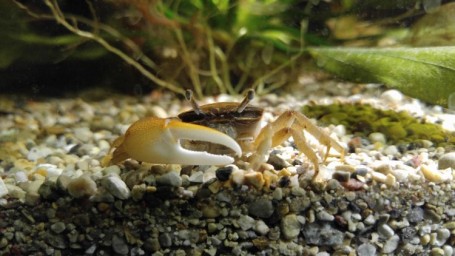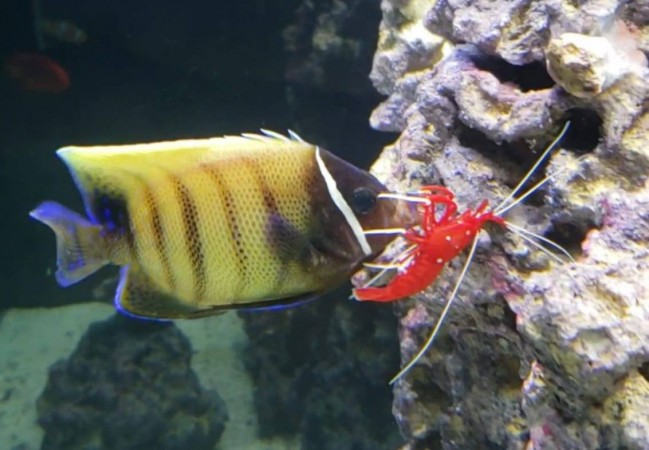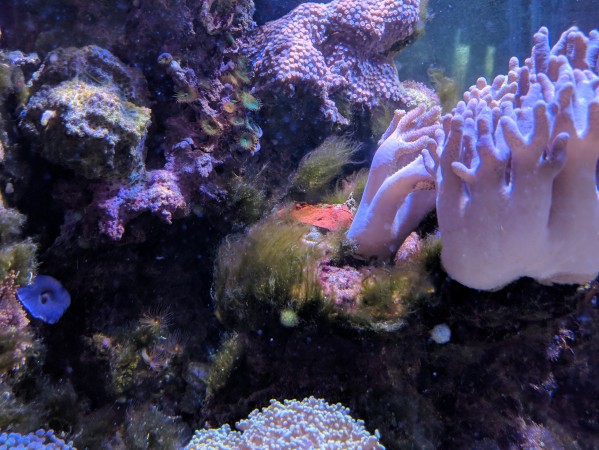- Name:
Fiddler Crab
(View AKA's) - Family: Ocypodidae
- Species: Crab
- Scientific Name: Uca sp


General info about Fiddler Crab
The group of crabs known commonly as fiddler crabs actually encompasses over 90 species and subspecies of the genus Uca. There are only 3 species which are native to the USA, which are Mud fiddlers, Sand fiddlers, and Red-Jointed fiddlers. Fiddler crabs are intertidal animals that live in mangrove forests, tidal creeks, sandbars, mudflats or, occasionally, stone or boulder beaches. They can occur in huge numbers, with thousands of individuals living in small, adjacent territories. Males and females live intermixed and each individual has its own burrow and a small area of surface sediment around it. These crabs need brackish water and are easy to keep as pets, with few health concerns and docile personalities. The largest fiddler crabs only reach a mature size of about 2 inches across their body.
They retreat to muddy burrows as the ocean tide goes out and they can also be found in brackish water swamps, which is where most pet fiddler crabs actually come from. Unlike land hermit crabs, fiddler crabs spend a lot of their time in the water and do not require shells to live in. Fiddler crabs are semi-terrestrial and like to burrow. It is important to remind you that Fiddler crab legs are designed to crawl on the sand, don't go for gravel because it makes it hard for them to crawl on. Even this can result in the death of fiddler. Fill the aquarium with at least a few centimeters of sand so that your crabs feel comfortable. Better to start with 4-5 centimeters of sand in the aquarium but if you have multiple crabs or want to give your crabs more space to burrow, add more sands. Pile most of the sand on one side of the tank until you get to the level you like.
One of the most important elements of a proper fiddler crab terrarium is the salt in the water. Most experts recommend putting aquarium salt (not table salt) in the water to mimic the brackish water in which your fiddler crab came from. Add enough salt to the water to attain a specific gravity between 1.005 and 1.010. The specific gravity can be determined by using an inexpensive hydrometer. Alternatively, your package of aquarium salt may have instructions for producing brackish water conditions by adding a certain amount of salt to a certain amount of water. It is okay to vary the salt concentration/specific gravity slightly as fiddler crabs would naturally experience some variations of salinity in the wild.
Don't house more than four crabs in one aquarium, because overcrowding is a big source of stress for crabs, and can lead to health problems. For one to four crabs, a 10-gallon tank is ideal. However, if the animals are larger or you have more than four, get at least a 20-gallon tank to avoid hostility between the crabs. Fiddler crabs do well at a range of temperatures between about 68 and 77 degrees Fahrenheit. Supplemental heat (a heating pad, water heater, or heat light) must be provided if temperatures do not fall within these ranges in your home. Because of their tropical origin, fiddler crabs prefer warmer waters and will die in cold water. Crabs are more active when their environment is warm. However, direct sunlight can kill fiddler crabs, so you want to put the aquarium in a warm spot out of the direct sun.
Signs of a healthy fiddler crab includes growth and regular molting. Once a crab molts, its previous exoskeleton can be found in its entirety in the tank. This exoskeleton looks a bit like your crab would look if it were a ghost. It is a good idea to leave this exoskeleton in the tank for at least a week or so in case your crab wants to ingest part of it. Exoskeletons serve as excellent sources of calcium, which a fiddler crab needs to produce a new one. Claws and legs may be lost during molts but they will regenerate over a couple of molting sessions. While molting, make sure to leave your fiddler alone during this time because she may be very fragile for several days. They may eat nothing during the molting.
It is good to place some decorations or plants in your tank. Fiddler crabs like to hide when they are scared or when they are molting, so placing a few decorations in the tank may make them more comfortable. Bu careful to add plastic plants or sticks because fiddler crabs will often destroy live plants. “Driftwood” types of sticks and rocks are good choices because they let your fiddler leave the water, which is vital to their health. Consider adding a piece of PVC piping for them to climb and hide. Make sure to rinse the piping out well before placing it in the tank.
Although fiddler crabs often travel and feed in groups, that they can be aggressive with one another. This can result in injury, but you may want to consider separating fiddlers if one doesn’t allow another to move throughout the aquarium. It would be best to keep one female and a male fiddler together in one tank as this will increase the lifespan a bit more. Two male fiddlers living under one roof will constantly be fighting and will eventually cause the weaker crab to lose one of its claws! However, if such a situation arises, the claw will grow back, while the intact claw grows even bigger than normal size.
Fiddler Crab Diet & Nutrition
In the wild, fiddler crabs are scavengers that eat bits of organic matter they find in the sand and mud. Thankfully, though, in the captivity, they can be fed with sinking crab food, fish food meant for scavengers (such as sinking tablets and shrimp pellets), and freeze-dried plankton and shrimp. These items should be readily available for you to purchase from any fish store. Also, you can offer blanched zucchini, blanched peas, and raw or boiled fish as well. Offering food a few times a week should suffice.
Determining Sex of Fiddler Crab
Male and female crabs are quite easily distinguished by their claws since the females have two small claws but the males have one very distinctive large claw. This large claw, held in such a way that it resembles a fiddle, is how fiddler crabs got their names.
Breeding & Spawning Fiddler Crab
Fiddler crabs may produce eggs in captivity but just because you see a female fiddler crab carrying eggs on its belly doesn't mean you'll have baby crabs. Successful rearing of young fiddler crabs in an aquarium is next to impossible due to the way their natural life cycle works. In the wild, the larvae of fiddler crabs grow in deep ocean waters and return to shore at maturity. Since aquariums are not deep enough to mimic this, the crab life cycle is rarely successfully completed in captivity.
Common Diseases with Fiddler Crab
Disease and illness are rare among fiddler crabs. Most of the health issues that fiddlers and other crabs experience in captivity have to do with poor water quality or an inadequate diet. You also want to take note of any foul odors coming from your crab's enclosure, which may indicate a fungus or a problem with the water salinity.
Although you can house fiddler crabs together, since males are highly territorial, avoid putting more than one male in a tank. They may fight and injure each other.
Fiddler Crab Origin
They can be found in the wild on ocean beaches in the inter-tidal zone. Those places are West Africa, the Western Atlantic, the Eastern Pacific, and the Indo-Pacific.
Caution with Fiddler Crab
Since the fiddler crabs that are found in pet stores are most likely semi-terrestrial, brackish water crabs, they will need some salt in their water in addition to dry land. Unfortunately, many pet stores keep fiddler crabs in a freshwater aquatic set up (and even refer to them as freshwater crabs) and then recommend the same to new owners. These crabs that are housed in freshwater may do fine for a few weeks but they will eventually become weak and die if they are not moved into brackish water. Therefore, if you are looking to purchase a new fiddler crab, find a pet store that keeps its crabs in brackish water. Also, while purchasing new crab, be sure to choose a crab that isn't missing any feet or claws as these can be indications of poor health. As fiddler crabs deteriorate in health, they begin to lose their limbs.
Chlorine can cause stress and kill fiddler crabs. You can make brackish water by mixing 1.5-2 liters of dechlorinated water with 1 gram or ½ teaspoon marine salts. As mentioned earlier, don't use table salt to make brackish water.
Original Detail
| Name | Species | Family | Scientific Name | More Detail | Added by |
|---|---|---|---|---|---|
| Fiddler Crab | Crab | Ocypodidae | Uca sp | The group of crabs known commonly as fiddler crabs actually encompasses over 90 species and subspecies of the genus Uca. There are only 3 species which are native to the USA, which are Mud fiddlers, Sand fiddlers, and Red-Jointed fiddlers. Fiddler crabs are intertidal animals that live in mangrove forests, tidal creeks, sandbars, mudflats or, occasionally, stone or boulder beaches. They can occur in huge numbers, with thousands of individuals living in small, adjacent territories. Males and females live intermixed and each individual has its own burrow and a small area of surface sediment around it. These crabs need brackish water and are easy to keep as pets, with few health concerns and docile personalities. The largest fiddler crabs only reach a mature size of about 2 inches across their body. They retreat to muddy burrows as the ocean tide goes out and they can also be found in brackish water swamps, which is where most pet fiddler crabs actually come from. Unlike land hermit crabs, fiddler crabs spend a lot of their time in the water and do not require shells to live in. Fiddler crabs are semi-terrestrial and like to burrow. It is important to remind you that Fiddler crab legs are designed to crawl on the sand, don't go for gravel because it makes it hard for them to crawl on. Even this can result in the death of fiddler. Fill the aquarium with at least a few centimeters of sand so that your crabs feel comfortable. Better to start with 4-5 centimeters of sand in the aquarium but if you have multiple crabs or want to give your crabs more space to burrow, add more sands. Pile most of the sand on one side of the tank until you get to the level you like. One of the most important elements of a proper fiddler crab terrarium is the salt in the water. Most experts recommend putting aquarium salt (not table salt) in the water to mimic the brackish water in which your fiddler crab came from. Add enough salt to the water to attain a specific gravity between 1.005 and 1.010. The specific gravity can be determined by using an inexpensive hydrometer. Alternatively, your package of aquarium salt may have instructions for producing brackish water conditions by adding a certain amount of salt to a certain amount of water. It is okay to vary the salt concentration/specific gravity slightly as fiddler crabs would naturally experience some variations of salinity in the wild. Don't house more than four crabs in one aquarium, because overcrowding is a big source of stress for crabs, and can lead to health problems. For one to four crabs, a 10-gallon tank is ideal. However, if the animals are larger or you have more than four, get at least a 20-gallon tank to avoid hostility between the crabs. Fiddler crabs do well at a range of temperatures between about 68 and 77 degrees Fahrenheit. Supplemental heat (a heating pad, water heater, or heat light) must be provided if temperatures do not fall within these ranges in your home. Because of their tropical origin, fiddler crabs prefer warmer waters and will die in cold water. Crabs are more active when their environment is warm. However, direct sunlight can kill fiddler crabs, so you want to put the aquarium in a warm spot out of the direct sun. Signs of a healthy fiddler crab includes growth and regular molting. Once a crab molts, its previous exoskeleton can be found in its entirety in the tank. This exoskeleton looks a bit like your crab would look if it were a ghost. It is a good idea to leave this exoskeleton in the tank for at least a week or so in case your crab wants to ingest part of it. Exoskeletons serve as excellent sources of calcium, which a fiddler crab needs to produce a new one. Claws and legs may be lost during molts but they will regenerate over a couple of molting sessions. While molting, make sure to leave your fiddler alone during this time because she may be very fragile for several days. They may eat nothing during the molting. It is good to place some decorations or plants in your tank. Fiddler crabs like to hide when they are scared or when they are molting, so placing a few decorations in the tank may make them more comfortable. Bu careful to add plastic plants or sticks because fiddler crabs will often destroy live plants. “Driftwood” types of sticks and rocks are good choices because they let your fiddler leave the water, which is vital to their health. Consider adding a piece of PVC piping for them to climb and hide. Make sure to rinse the piping out well before placing it in the tank. Although fiddler crabs often travel and feed in groups, that they can be aggressive with one another. This can result in injury, but you may want to consider separating fiddlers if one doesn’t allow another to move throughout the aquarium. It would be best to keep one female and a male fiddler together in one tank as this will increase the lifespan a bit more. Two male fiddlers living under one roof will constantly be fighting and will eventually cause the weaker crab to lose one of its claws! However, if such a situation arises, the claw will grow back, while the intact claw grows even bigger than normal size. |
PalaciosAn |
Changed by users
| Submitted Date | Submitted By | Status | Action |
|---|



